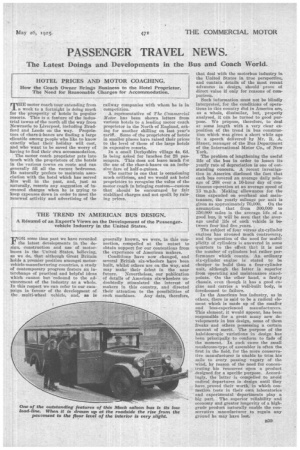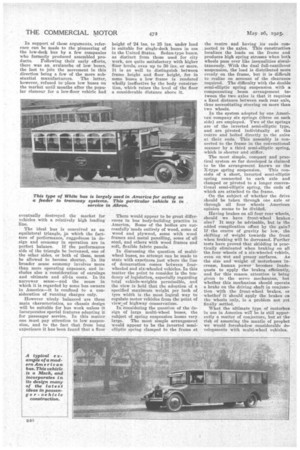THE TREND IN AMERICAN BUS DESIGN.
Page 23

Page 24

If you've noticed an error in this article please click here to report it so we can fix it.
A Résumé of an Expert's Views on the Development of the Passengervehicle Industry in the United States.
FOR some time past we have recorded the latest developments in the design, construction and use of motorbuses in the United States, believing, as we do, that although Great Britain holds a premier position amongst motorvehicle-manufacturing countries, a study of contemporary progress fosters an interchange of practical and helpful ideas which cannot but "redound to the advancement of the industry as a whole. In this respect we can refer to our campaign in favour of the developpient of the multi-wheel vehicle, and, as is generally known, we were, in this connection, compelled at the outset to obtain support for our contentious from the experience of American makers.
Conditions have now changed, and several British six-wheelers have been built, whilst others are on the way, and may make their debut in the near future. Nevertheless, our publication of details of American ix-wheelers undonhtedly stimulated the interest of makers in this country, and directed their attention to the possibilities of such machines. Any data, therefore, that deal with the motorbus industry in the United States in true perspective, and contain details of the most recent advances in design, should prove of direct value if only for reasons of comparison.
Such information must not be blindly interpreted, for the conditions of operations in this country and in America are, as a whole, dissimilar, but, properly analysed, it can be turned to good purpose. We propose, therefore, to deal at some length with a very clear exposition of the trend in bus construction which was given a short while ago in a speech delivered by Mr. It. A. Hauer, manager of the Bus Department of the International Motor Co., of New York.
The problem of lengthening the useful life of the bus in order to lessen its yearly rate of depreciation is one of outstanding concern. A recent investigation in America disclosed the fact that each bus covered an average daily mileage of 208 over a I6-hour day of continuous operation at an average speed of 13 M.p.h. Making allowances for the time expended on overhaul and maintenance, the yearly railei'vee per unit is given as approximately 70,000. On the assumption that from 300,000 to 350,000 miles is the average life of a 'good bus, it will be seen that the average useful life of each vehicle is between four and five years.
The subject of four versus six-cylinder engines has aroused much controversy, and the question of the need for multiplicity of cylinders is answered in some Quarters to the effect the it is not the number of cylinders but rather performance which counts. An ordinary six-cylinder engine is stated to be cheaper to build than a four-cylinder unit, although the latter is superior from operating and maintenance standpoints. On the other hand, a faulty chassis, even though it has a good en-, glue and carries a well-built body, is foredoomed to failure.
In the American bus industry, as in others, there is said to be a radical element which is made up of the smaller and less-experienced manufacturers. This element, it would appear, has been responsible for a great many new developments in bus design, some of them freaks and others possessing a certain amount of merit. The purpose of the kaleidoscopic variations in design has been principally to conform to fads of the moment, In such eases the small mushroom-type of assembler is often the first in the field, for the more conservative manufacturer is unable to trim his sails to every passing vagary cif the wind, by reason of the need for concentrating his resources upon a product designed for a specific purpose. Accordingly, the latter is compelled to avoid radical departures in design until they have proved their worth, in which connection tests in their own laboratories and experimental departments play a big part. The superior reliability and economy and greater longevity of a highgrade product naturally enable the conservative manufacturer to regain any ground he may have lost.
In support of these arguments, reference can be made to the pioneering of the low-deck bus by a few companies who formerly produced assembled pro ducts. Following their early efforts, there was an. avalanche of low buses, the last to join the movement in this direction being a few of the more substantial manufacturers. The latter, however, refused to place low buses on the market until months after the popular clamour for a low-floor vehicle had eventually destroyed the market for vehicles with a relatively high loading line.
The ideal bus is conceived as an equilateral triangle, in which the facttors of performance,' ruggedness in design and economy in operation are in perfect balance. If the performance side of the triangle he increased, one of the other sides, or both of them, must be allowed to become shorter. In its broader sense economy involves more than mere operating expenses, and includes also a consideration of earnings and ultimate and all-in costs. In its narrower sense—and the sense in which it is regarded by some bus owners in America—it is confined to a consideration of running charges only.
However nicely balanced are these main characteristics, no chassis design will be suitable for bus work unless it Incorporates special features adapting it for passenger service. In this matter one must pay attention to low suspension, and to the fact that from long experience it has been found that a floor height of 24 ins. to 25 ins, under load is suitable for single-deck , buses in use in the United States. Sedan-type buses, as distinct from those used for city work, are quite satisfactory with higher floor levels, even up to 30 ins, or more. it is as well to distinguish between frame height and floor height, for in some buses a low frame is rendered wholly ineffective by the body construction, which raises the level of the floor a considerable distance above it.
There would appear to be great differences in bus body-building practice in America. Some of the bodies are successfully made entirely of wood, some of wood and plywood, some with wood frames and metal panelling, some of all steel, and others with wood frames and soft, flexible fabric panels.
In discussing the question of multiwheel buses, no attempt can be made to state with exactness just where the line of demarcation comes between fourwheeled and six-wheeled vehicles. In this matter the point to consider is the tendency of legislation, especially regarding total vehicle-weights permissible, and the view is held that the adoption of a specified maximum weight per inch of tyre width is the most logical way to regulate motor vehicles from the point of view2,of highway conservatism.
In considering the ouestion of the design of large multi-wheel buses, the subject of spring suspension looms very large. The most simple arrangement would appear to be the inverted semielliptic spring clamped to the frame at the centre and having its ends connected to the axles. This construction localizes the loads on the frame and produces high spring stresses when both wheels pass over like inequalities simultaneously. With the dual full-cantilever suspension, the load is distributed more evenly on the frame, but it is difficult to realize on account of the clearance required. The difficulty with the double semi-elliptic spring suspension with a compensating beam arrangement between the two axles is that it requires a fixed distance between each rear axle, thus necessitating steering on more than two wheels.
In the system adopted by one American company six springs (three on each side) are employed. Two of the springs are of the inverted semi-elliptic type, and are pivoted individually at the centre and bolted directly to the axles at their ends. This assembly is connected to the frame in the conventional manner by a third semi-elliptic spring, which is shorter and stiffer.
The most simple, compact and practical system 80 far developed is claimed to be the arrangement known as the X-type spring suspension. This consists of a short, inverted semi-elliptic spring connected to each axle and clamped or pivoted to a longer conventional semi-elliptic spring, the ends of which are attached to the frame.
On the subject of whether the drive should be taken through one axle or through all four wheels American opinion seems to be divided.
Having brakes on all four rear wheels, should we have front-wheel brakes also? It may be advisable, but is the added complication offset by the gain? If the centre of gravity be low, the shifting of weight towards the front when braking will be decreased. Further tests have proved that skidding is practically eliminated when braking on all the four wheels of a six-wheeled vehicle, even on wet and greasy surfaces. As the size and weight of motorbuses increase, human power becomes inadequate to apply the brakes efficiently, and for this reason attention is being given to the servo mechanism, but whether this mechanism should operate a brake on the driving shaft in conjunction with the front-wheel brakes, or whether it should apply the brakes. on the wheels only, is a problem not yet finally settled.
What the ultimate type of motorbus in use in America will be is still apparently a matter of conjecture, but at the risk of assuming the mantle of prophet we would foreshadow considerable developments with multi-wheel vehicles.
































